Palladyne AI Marks Significant Progress with First Autonomous Tracking Flight of Small Drone
Image Source: Palladyne AI
Palladyne AI Corp., a leader in artificial intelligence solutions for robotic and unmanned systems within the industrial and defense sectors, has announced a pivotal achievement in its developmental roadmap. The company's flagship Palladyne™ Pilot AI software platform successfully conducted its inaugural autonomous tracking flight using a third-party small drone, showcasing advanced capabilities in target identification, prioritization, and autonomous navigation.
[Read More: United by AI: 20 Drones Join Forces to Battle Wildfires]
Breakthrough in Autonomous Drone Tracking
Palladyne AI's latest milestone demonstrates the Palladyne Pilot AI platform's enhanced ability to autonomously manage drone operations. In the successful test flight, the platform enabled a commercially available small drone to identify terrestrial targets, prioritize them based on predefined criteria, and seamlessly integrate with the drone's existing autopilot system to autonomously track and follow the selected target. This achievement marks the first instance where Palladyne Pilot has been effectively combined with third-party autopilot software, setting a new standard for interoperability and autonomous functionality in small drone operations.
[Read More: AI Can Handle 100 Drones at a Time!]
Advanced AI Technology at the Core
At the heart of this accomplishment lies Palladyne Pilot's sophisticated artificial intelligence framework. The platform employs advanced perception algorithms and machine learning techniques to enable real-time analysis and decision-making. By leveraging these technologies, Palladyne Pilot can continuously assess the environment, distinguish relevant targets from background noise, and prioritize them based on mission-specific parameters.
The AI system utilizes computer vision and sensor fusion to gather comprehensive data from the drone's surroundings. This data is then processed through neural networks that have been trained to recognize and classify various terrestrial objects, ensuring accurate and reliable target identification. Additionally, the platform's autonomous navigation capabilities are powered by adaptive learning algorithms that optimize flight paths and tracking behaviours, allowing the drone to maintain focus on prioritized targets even in dynamic and unpredictable environments.
Insights from Palladyne AI’s CTO
Dr. Denis Garagic, co-founder and Chief Technology Officer of Palladyne AI, expressed enthusiasm about the recent developments.
“Our first autonomous flight with Palladyne Pilot was able to track and follow a target, successfully demonstrating how powerful our AI platform can be by automating those functions where algorithms and machines excel while still leaving ultimate control in the hands of humans”, he stated.
Dr. Garagic emphasized that the integration of Palladyne Pilot with third-party autopilot systems broadens the platform’s applicability, making sophisticated intelligence capabilities accessible to a wider range of drone models.
[Read More: Thales Unveils AI-Driven Drone Swarms: Enhanced Autonomy & Mission Flexibility]
Path to Commercialization by Early 2025
Palladyne AI is on track to bring the Palladyne Pilot AI platform to market by the end of the first quarter of 2025. The company aims to democratize access to high-level autonomous functionalities, traditionally reserved for larger and more expensive unmanned systems. By equipping small, cost-effective drones with Palladyne Pilot, Palladyne AI envisions a future where intelligent, autonomous operations are standard across various applications in both industrial and defense landscapes.
Comprehensive Capabilities of Palladyne Pilot AI Platform
The Palladyne Pilot AI Software Platform is engineered to transform unmanned aerial vehicles (UAVs) into powerful, autonomous force multipliers. Key features include:
Persistent Target Tracking: Maintains continuous focus on selected targets, ensuring reliable monitoring over extended periods.
Dynamic Collaboration: Enables multiple drones to work in tandem, sharing data and coordinating actions to achieve mission objectives efficiently.
Enhanced Situational Awareness: Provides real-time insights and comprehensive understanding of the operational environment through advanced data processing and analysis.
These capabilities are designed to minimize the operational burden on human operators while significantly enhancing mission effectiveness and success rates in complex military and defense operations.
[Read More: AI Arms Race: Navigating the Tumultuous Waters of Global Tech Dominance]
Strategic Development and Future Outlook
The development of Palladyne Pilot has been supported by multiple contracts with the U.S. Air Force, underscoring the platform’s strategic importance and potential impact on defense operations. From its inception, Palladyne Pilot was envisioned as a collaborative sensing solution tailored for small drone platforms, complementing Palladyne AI’s other technological offerings, including Palladyne IQ.
Looking ahead, Palladyne AI is poised to expand its technological advancements and market reach. The successful integration of Palladyne Pilot with third-party drones not only validates the platform’s versatility but also sets the stage for broader adoption across various sectors. As the company moves towards commercialization, it is well-positioned to lead the evolution of autonomous unmanned systems, delivering cutting-edge AI solutions that enhance operational capabilities and mission outcomes.
[Read More: OpenAI and Anduril Forge Strategic Partnership to Enhance U.S. Defense AI Capabilities]
About Palladyne AI Corp.
Palladyne AI Corp. specializes in developing artificial intelligence software for robotic and unmanned platforms within the industrial and defense sectors. The company's innovative solutions aim to enhance the autonomy, efficiency, and effectiveness of unmanned systems, driving advancements in both commercial and military applications.
[Read More: Chinese Researchers Develop Feather-Light Drone with Near-Infinite Flight Potential]
Source: Drone Life












